Collisions, injuries and the changing nature of rugby: 2013/14 to early 2017/18
The Times of London has run a number of pieces this week on the subject of player injuries. “Inquest into injuries in the Aviva Premiership“i was the starting headlineii, with various accompanimentsiii.
It points to an injury epidemic in Premiership Rugby, attributed to a sharp/sudden increase in ball in play time, tackles and rucks since last season. It “revealed”iv that rugby’s most recent law changes are responsible for the above increases which are in turn leading to increased injuries. This baton has also been picked up in various ways by BBCv, the Telegraphvi, Wales Onlinevii, the Mirrorviii.
The timing of such worry is perhaps unsurprising. There is a special focus on player welfare in English rugby right now given the desire of Premiership clubs to extend the length of their season, a move that Billy Vunipola and other high profile players have spoken out against publicly.
In three simple statements here’s a summary of the case being made:
Statement 1: there is an injury crisis in Premiership rugby, including some high profile players out for extended periods
…because…
Statement 2: there have been an extra 50 collisions per game this Premiership season compared to 2016/17
…because…
Statement 3: this increase in collisions has been revealed [their word, not my word] to be the result of law changes made prior to the Northern Hemisphere’s 2017/18 season.
Full Disclosure: McGeady was skeptical coming in to this
To be clear, I came to this with a sceptical attitude. Firstly, it’s really early in the season. Secondly, I’d gone through all of those law changes prior to the season and my eyes hadn’t seen anything hugely amiss in terms of game play. Thirdly, I hadn’t seen where changes could actually be tied to a significant change in the game.
hmm…. https://t.co/a46iqmcmtF
— Andy McGeady (@andymcgeady) October 3, 2017
But I really wanted to know if my scepticism was warranted. Let’s have a look at each in turn. 1: There is an injury crisis in Premiership rugby, including some high profile players. Are there a lot of injured players right now? According to various clubs, yes. But what has been made public so far is anecdotal stuff. The only quantitative data made public, even if available, is the number of players currently unavailable for particular clubs. This does not tell us whether this is a spike. We do not know how much player time is being lost relative to last season, or the seasons before that. More to the point, even if this is a spike relative to previous norms we do not know if it is unusual to have a similar bump over any five week stretch in a season. However, in the interest of exploration and good faith, this parish will accept the premise that there is currently an injury spike in Premiership Rugby. So, what has caused this injury spike?
“the law changes which came into force this season are being cited as a potential cause for the attrition rate, with clubs reporting about 50 more collisions per match.”
Hmm… We have a lot to unpack here. 2: there have been an extra 50 collisions per game this Premiership season compared to 2016/17 Before we begin, placed right up high in one Times piece we read the following:
“It is too early for any robust statistical analysis of the factors behind the number of early-season injuries”.
This is a very important statement. It is also the equivalent of a newspaper’s lawyers getting their hands on a piece containing the mention of various heinous crimes and, in the same piece, the mention of a particularly prominent person. Said lawyers then insist upon the insertion of something along the lines of “There is no allegation of illegal activity or wrongdoing”. After that we get to the nuts of it. The numbers. The collision numbers.
“The number of tackles per game has increased, on average, from 248 to 273 and there are ten more rucks per game because the laws are encouraging higher ball-in-play time. That increase, based on official statistics from Opta, does not include those which occur when players compete in the air or engage in counter-rucking.”
How do we get to “about 50 more collisions per match”? Well, I got stuck in. Courtesy of the good people of Opta I got my hands on the numbers for Premiership rugby for the seasons in question. And yes, there has been an increase in both tackles and rucks per game since last season. Based on Opta’s average per game numbers, across the Premiership there have been 37 more tackles and rucks per game. Add collisions that lie outside this dataset but which one certainly sees in the game, such as counter-rucking and clearouts, and an overall increase of “about 50” is not unreasonable. But what does an extra 37 tackles and rucks actually mean? What is the context? Strap yourselves in. Data incoming.
Context, Part One
These extra 37 tackles and rucks are an increase on the 427 tackles and rucks in the average 2016/17 Premiership game. Through five rounds of this 2017/18 season the average game has had 464 tackles and rucks, meaning an increase of 9%.
A 9% increase in collisions? That sure seems like a spike.
Context, Part Two
Thing is… we also saw a 9% increase in tackles and rucks from 2015/16 to 2016/17.
Context, Part Three
And… we also saw a 9% increase from 2014/15 to 2015/16. 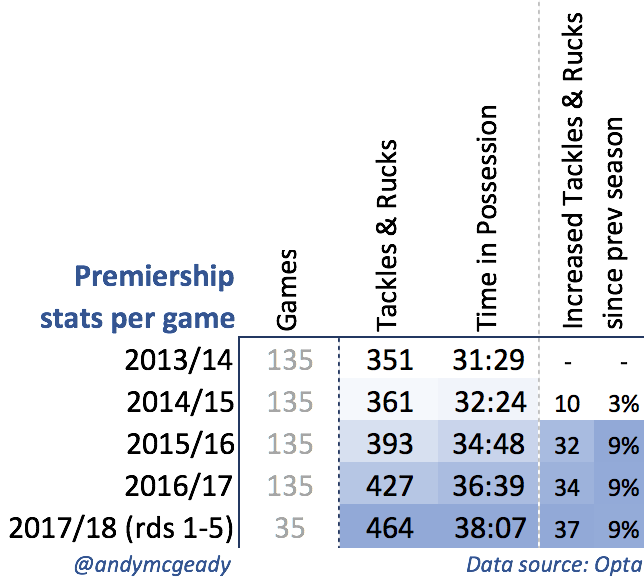 You need to go back to the increase of 3% between 2013/14 and 2014/15 before you get below a season on season increase in tackles and rucks of 9%. ix
You need to go back to the increase of 3% between 2013/14 and 2014/15 before you get below a season on season increase in tackles and rucks of 9%. ix 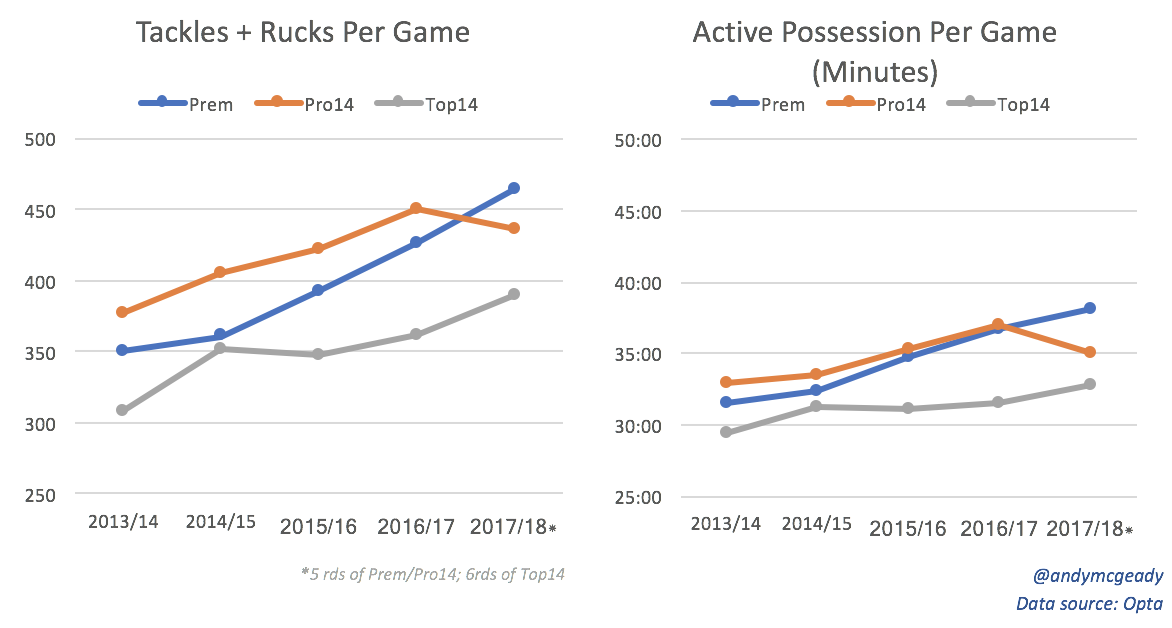 A picture tells a thousand words. Can you see a sudden increase in tackles and rucks per game in the Premiership in 2017/18? Can you see a sudden jump in ball in play time in the Premiership in 2017/18? It’s just not there. 3: this increase in collisions has been revealed [not my word] to be the result of law changes made prior to the Northern Hemisphere’s 2017/18 season. Between World Rugby’s global law trials and amendments there are a total of 16 law changes in place this Northern Hemisphere season, from ruck interpretation to the scrum feed to captains being able to choose a better penalty location. But it’s a bit of a stretch to attest that these 16 law changes are to blame for a sudden, sharp spike in collisions and ball in play time when there has been no sudden, sharp spike in collisions and ball in play time. However, any increase in tackles and rucks is probably not a good thing. Collision events have a high potential for injury.
A picture tells a thousand words. Can you see a sudden increase in tackles and rucks per game in the Premiership in 2017/18? Can you see a sudden jump in ball in play time in the Premiership in 2017/18? It’s just not there. 3: this increase in collisions has been revealed [not my word] to be the result of law changes made prior to the Northern Hemisphere’s 2017/18 season. Between World Rugby’s global law trials and amendments there are a total of 16 law changes in place this Northern Hemisphere season, from ruck interpretation to the scrum feed to captains being able to choose a better penalty location. But it’s a bit of a stretch to attest that these 16 law changes are to blame for a sudden, sharp spike in collisions and ball in play time when there has been no sudden, sharp spike in collisions and ball in play time. However, any increase in tackles and rucks is probably not a good thing. Collision events have a high potential for injury.
“More collisions almost inevitably mean more injuries because tackles, rucks and other non set-piece collisions accounted for more than 70 per cent of injuries, according to the most recently published audit.”
This is entirely reasonable. The audit referred to is the RFU’s 2015/16 RFU Injury reportx, the latest in a superb annual series that is a valuable asset to the sportxi. For the sake of argument, however, let us for a moment assume that all data prior to 2016/17 has been lost and assume that these law trials and amendments have indeed had an impact visible in the collision numbers. These are global trials, so we should see this across European rugby whether in terms of collisions or ball in play time.
First, the Premiership: rises across the board. Everything is up compared to last season. Looks pretty conclusive.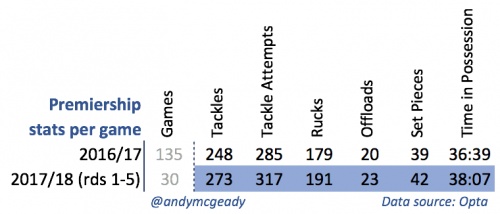
Next, the Top14: same again. Rises across the board. Everything is up compared to last season. Looks pretty conclusive.
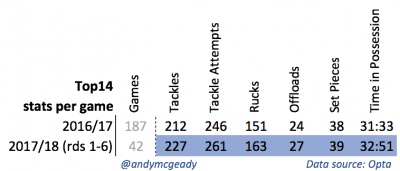
And on to the Pro12/14: Same again. Everything is… hold on, what?
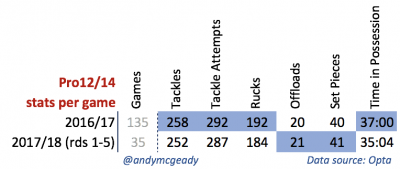
Tackles, rucks and game time in the Pro14 are down?
Remember that we are not even past the one quarter mark of the 2017/18 season. It’s far too early to make sweeping conclusions here. The Pro14 stats could well be five weeks of noise, or it could be the addition of two South African teams, or games with fewer tackles because of lots of defenders beaten (note: Pro14 tackle attempts are also down). But if one is to attest that an increase in the Premiership is down to global law changes from on high… well…
We need more data
Can do. Here’s data from the three major European professional leagues from October 4th 2017 back to the 2013/14 season. Again, this is courtesy of Opta. For clarity, these data were put together using the season team average files and multiplied out. Any errors in calculation are mine alone. 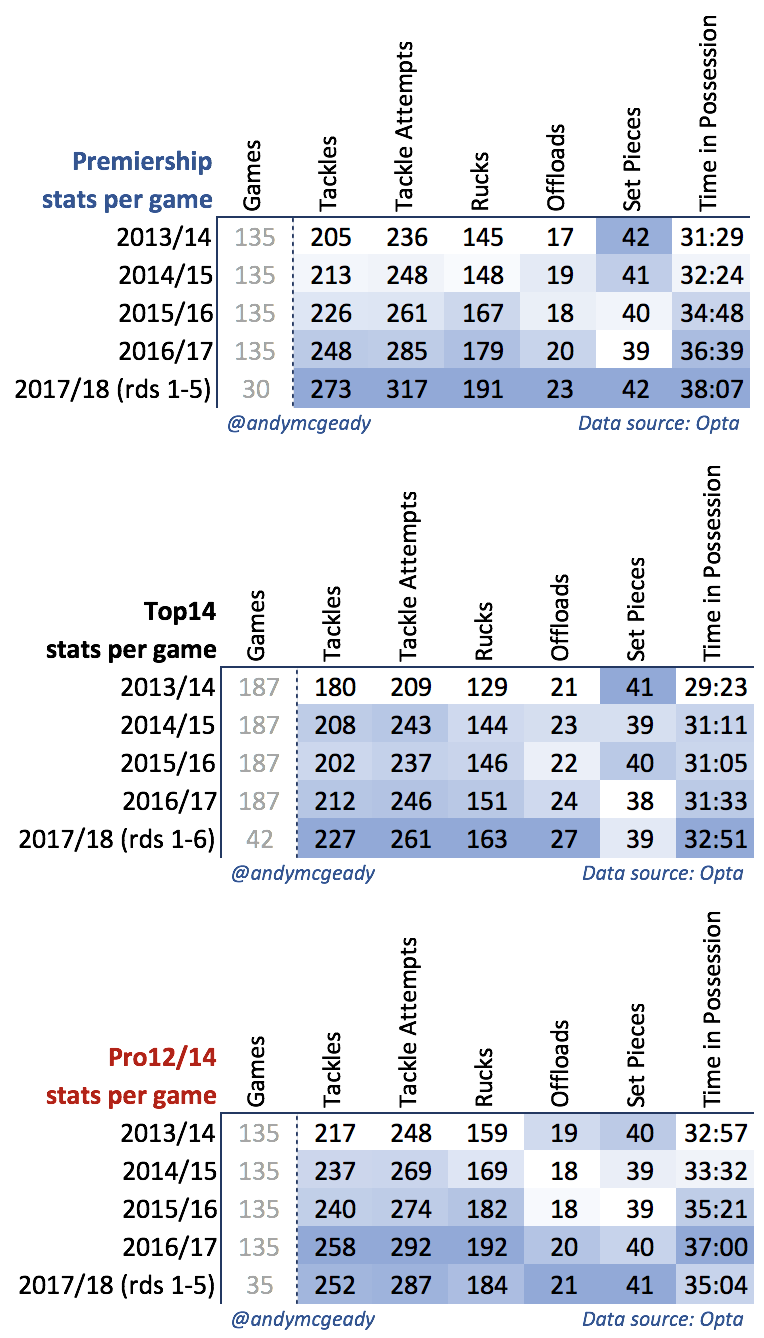
A Tale of Three Leagues
What we have here is a tale of three leagues that are quite different but have, over time, shared some common trends. The Pro12/14 has consistently had more time in possessionxii (read: Ball in Play), tackles and rucks than Premiership Rugby and the Top14. The Top14, despite the lowest active game time of all three leagues, consistently has the highest offload figures by far (both raw numbers per game and when compared to active game time). Premiership rugby is unique among the three leagues to post increases in time in possession, tackles and rucks every season since 2013/14. Even with this small dip in the Pro14, all three leagues have more ball in play time, tackles and rucks since 2013/14. Injuries aside, who is interested in this stuff? These differences, both in raw numbers and rates of increase/decrease, are potentially useful to a number of people across rugby. A strength & conditioning coach might look at a game that is consistently increasing its demands on the player to be both more aerobic (general increases in ball in play time since 2013/14) while also needing to be more physically resilient (increases in collisions). These two goals are not always aligned; an example of this is the weight gain a contracted Sevens player might have to undertake in order to withstand the collisions in the 15s game. A coach or lead analyst might look at these league-wide numbers as context for their own internal stats. They’ll also see tournaments that prepare teams, and players, for different playing experiences. A Pro14 team coming up against a Top14 side in Champions Cup play, for example: one side is used to playing fewer active minutes per game – can this difference be exploited? A sporting administrator, perhaps based in a sport’s governing body’s offices, or sports scientist, or researcher, might look at this in the context of seeing changes in the Shape of the Game, or in terms of the potential for injury. And they’ll hopefully look at far more data than what’s on this page to reach any firm conclusions as to significance, let alone cause. 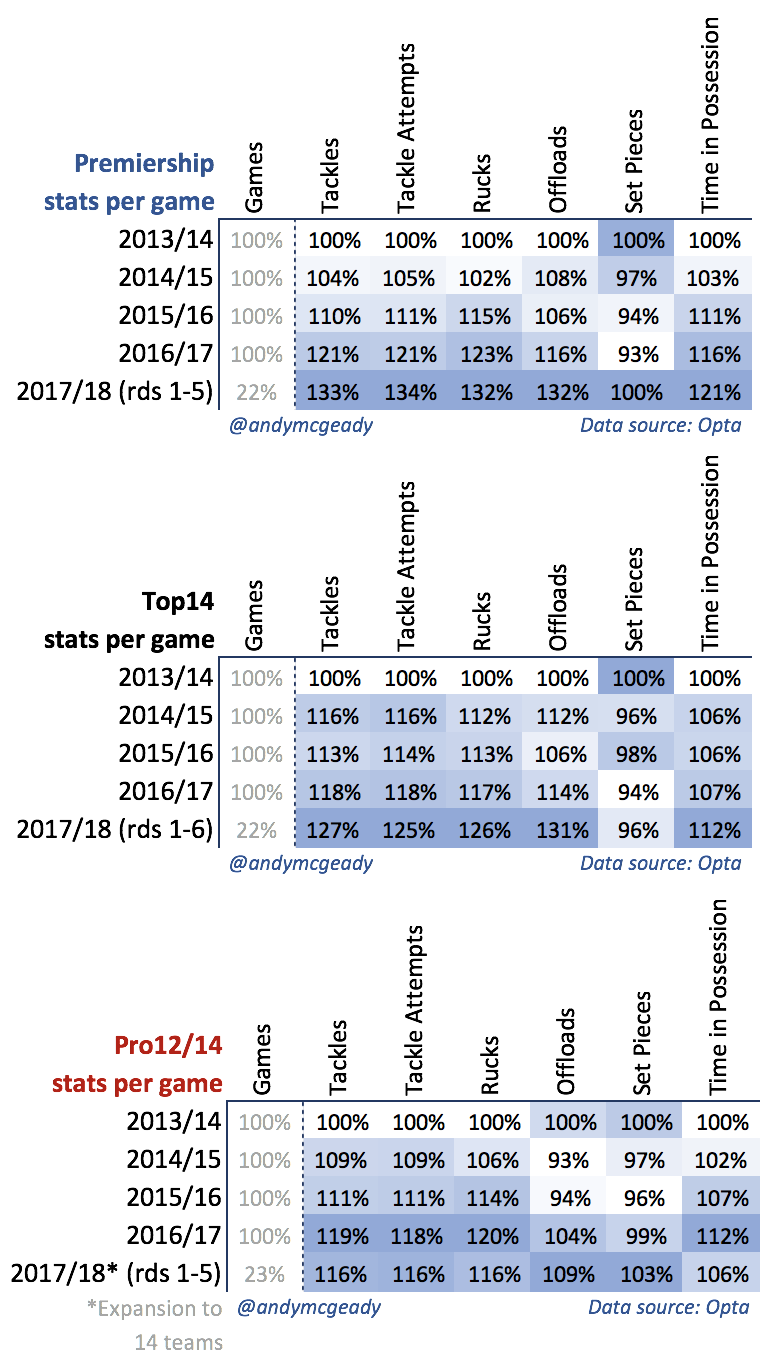
Those coaches, players and S&C folks might be the very same people who are expressing concern about their players, their employees, their friends. Seeing lots of injuries in a short space of time is not good, and it’s natural to look for a cause. But based on the game data it is not reasonable to state that that there has been a sudden, sharp spike in playing time, tackles and rucks in Premiership Rugby in the first five weeks of this season. And without that spike, you really don’t get to point fingers at law changes. But questions are good. And it’s always worth asking good questions… Ross Tucker, for one, has asked some good questions about this. For example: has there been a change in the relationship between tackles and rucks, perhaps visible in offload numbers? That is an interesting one to explore.xiii
Note that this shows an increased rate of tackling even after correcting for ball in play time. Question is why?
— Ross Tucker (@Scienceofsport) October 3, 2017
More questions…
- Why are tackles and rucks increasing at a faster rate than ball in play time?
- Why were there consistently more tackles and rucks in the Pro14 from 2013/14 through 2016/17?
- Why has the Premiership seen a sharper rise in collisions than the Pro14 or Top 14 since 2014/15?
- Why is the number of collisions in the Premiership rising at a greater rate than the increase in ball in play time?
- Why has there been there a dip in ball in play time in the Pro14 in 2017/18? Is this just noise?
- Why was there a dip in tackles and offloads in the Top14 in the 2015/15 season?
- If there has not been a sudden increase in collisions over and above previous seasons’ increases, has there been a change in the nature of collision?
Remember, we have no comprehensive dataset for the current season’s injuries. As the Times itself recognises we’ll be a while waiting for that one; the 2016/17 surveillance report is not out so the 2017/18 edition will be some time yet.
And there are far more questions than this.
Better questions.
And better uses of this data.
This is not finished. There is more to do.
This not exhaustive. I have yet more tables and graphs comparing such things as the “extra” number of collisions in a season compared to what one might have expected based on the increase in playing time alone (see one of the questions above). Because it’s not a linear relationship. That’s one example.
And I’m sure there has been a mistake made along the way in putting this together. I’ve stolen time from sandwiches and sleep, plugging it together on trains, buses and in coffee shops. I didn’t pitch this to anybody because I knew there’d be a crapload of numbers in it and didn’t know when I could commit to having it done. And, per previous paragraph, it’s not yet done.
But this is where I take pause, and publish. I think the reasoning is sound. And I think the data is sound.
And, most of all, I think I’ve tried to start from the right place.
Update 11/10/2017: The author of that first piece in the Times of London was Alex Lowe, who reported the existence of a theory in Premiership clubs that the new laws were to blame for an increase in collisions leading to an increase in injuries.
I had issues with how stats were used in that piece to support the theory, hence the words, tables, and charts above.
I had issues with how the same outlet subsequently referred to a proven causal link between new 2017/18 laws, increased collisions, and injuries.
But I had no issues with the original reporting explaining that this theory existed. And, in fairness to Alex, my writing does not make that distinction entirely clear.
We have have spoken since I published this. We have exchanged views. Alex did not ask me to add this note; I have done so because I think it’s the right thing to do.
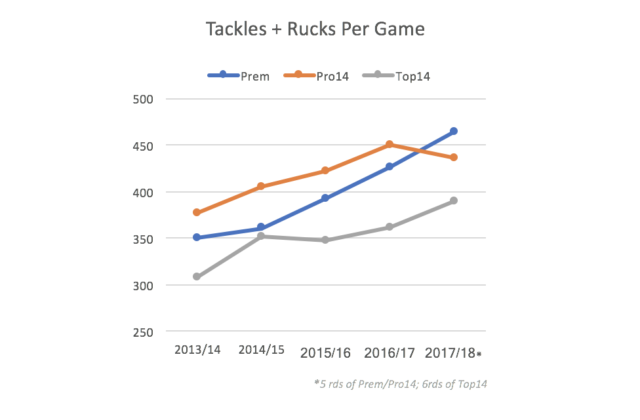

Thanks Andy, good read…have you any data that relates to the number of injuries and the excessive use of subs.
i.e. a whole new pack coming on midway through the second half, etc ., big, heavy players being replaced by sometimes even bigger heavier players.
Also is there any data related to an increase in injuries suffered by backs in relation to that of forwards. (could relate to the ruck and maul law changes).